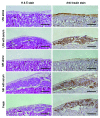Improved hypothermic short-term storage of isolated mouse islets by adding serum to preservation solutions
- PMID: 23552019
- PMCID: PMC3655792
- DOI: 10.4161/isl.24025
Improved hypothermic short-term storage of isolated mouse islets by adding serum to preservation solutions
Abstract
Preserving isolated islets at low temperature appears attractive because it can keep islet quantity comparable to freshly isolated islets. In this study, we evaluated the effect of serum as an additive to preservation solutions on islet quality after short-term hypothermic storage. Isolated mouse islets were preserved at 4°C in University of Wisconsin solution (UW) alone, UW with serum, M-Kyoto solution (MK) alone or MK with serum. We then assessed islet quantity, morphology, viability and function in vitro as well as in vivo. Islet quantity after storage in all four solutions was well maintained for up to 120 h. However, islets functioned for different duration; glucose-stimulated insulin release assay revealed that the duration was 72 h when islets were stored in UW with serum and MK with serum, but only 24 h in UW alone, and the islet function disappeared immediately in MK alone. Viability assay confirmed that more than 70% islet cells survived for up to 48 h when islets are preserved in UW with serum and MK with serum, but the viability decreased rapidly in UW alone and MK alone. In in vivo bioassays using 48-h preserved isogeneic islets, all recipient mice restored normal blood glucose concentrations by transplants preserved in UW with serum or MK with serum, whereas 33.3% recipients and no recipient restored diabetes by transplants preserved in UW alone and in MK alone respectively. Adding serum to both UW and MK improves their capability to store isolated islets by maintaining islet functional viability.
Keywords: M-Kyoto solution; University of Wisconsin solution; hypothermic short-term storage; islet; serum.
Figures





References
-
- Jahr H, Hussmann B, Eckhardt T, Bretzel RG. Successful single donor islet allotransplantation in the streptozotocin diabetes rat model. Cell Transplant. 2002;11:513–8. - PubMed
Publication types
MeSH terms
Substances
LinkOut - more resources
Full Text Sources
Other Literature Sources
